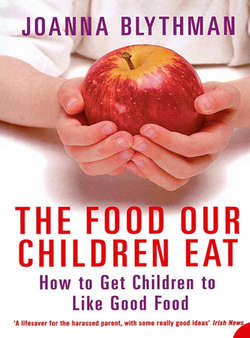Читать книгу The Food Our Children Eat: How to Get Children to Like Good Food - Joanna Blythman, Joanna Blythman - Страница 13
SWEETS AS FOOD
ОглавлениеChildren have been eating sugary and chocolaty sweets for as long as any of us can remember. A love of sweet snacks in all forms is a regular feature of childhood.
Many adults remember with great fondness the thrill of having money to spend in the sweet shop and the lure of everything from penny caramels to sherbet flying saucers.
However, the way we think about sweets has changed. We used to think of them as a different category of edible – a treat, perhaps, a bit of frivolous window-dressing after the main business of eating had been concluded. Very few people would have considered them to be a substitute for a child’s mainstream nutrition. Nowadays, however, sweets are increasingly considered the main event. It is not uncommon, for example, for children to be given a chocolaty candy bar in their lunch boxes, often as an alternative to a pudding such as yogurt or fresh fruit. In 1998 when the caterer Gardner Merchant surveyed children’s eating habits, it found that 39 per cent of children brought a chocolate bar to school in their lunch box.
It seems that sweet confectionery is increasingly being given to children as a staple part of their diet. We no longer expect them to fill up on ‘proper’ food, offering sweets as an add-on, but often rely on confectionery as food itself. The survey mentioned above also found that one in four children substituted sweets, crisps and savoury snacks for their traditional hot evening meal.
This shift in thinking has a lot to do with the power of advertising, particularly on television. Sweets are ruthlessly hyped to children through advertising which makes them desire them. Once they taste sweets, they do like them because the hefty serving of sugar, salt, and fat they offer can be irresistible, encouraging a palate that seeks that instant fix in other foods. Judged against this craving, real, natural, unprocessed foods just don’t taste right and, unlike the commercial might of the confectionery industry, they don’t have any powerful interests promoting them.
Most people know that, eaten in significant quantity, sweets and chocolate confectionery are bad for children’s health. If parents don’t intervene, the sheer weight of commercial pressure on children to eat confectionery is so strong that they will end up eating much more than the relatively harmless quantity of ‘add-on’ sweets we often associate with our own childhood.
The dilemma for worried parents is how to discourage consumption of sugary confectionery without appearing to ban or proscribe it, especially because it is such a big component of the ubiquitous children’s diet. However, despite the pressure on children to want confectionery – and to replace other more wholesome foods with it – they can be influenced to restrict or severely limit consumption of their own volition.
How can parents achieve this?
We need to start approaching the problem not in a futile ‘Sweets are bad, you aren’t allowed them’ way but as part of an overall strategy towards eating, outlined in detail elsewhere in this book, that will encourage children to select food that is nutritious and good for them. The objective – a surprisingly achievable goal – is to produce children who will happily eat their Clementine or yogurt when the rest of the class is munching away on fatty-sugary sweets.
Parents can achieve this by using the general approach outlined in Part Two, Breaking the Mould at Home, which is aimed at producing children who, of their own accord, will enjoy a wide range of food and select a diet that is broadly wholesome and good for them. Part Three, The Gentle Art of Persuasion, is a troubleshooting section to help parents who find it hard to make the approach in Part Two stick. Part Seven, Nitty-gritty Ideas and Recipes for Inspiration, lists wholesome foods that can be offered in specific situations as an alternative to confectionery and other junk food. Finally, for a strategy that tackles the vexed question of sweets head-on, see pages 91–5, Sweets, Treats and Bans.
